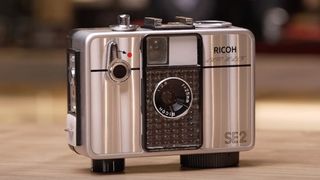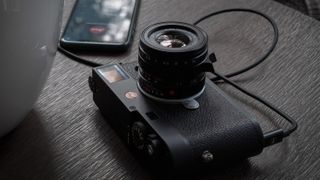Film cameras are back – and Pentax’s new compact camera could soon suck you into the analogue revival
- Pentax’s new film camera will finally be launched in mid-2024
- It will be a half-frame compact camera, with both electronic and manual controls
- The lens will be based on the Ricoh Auto Half and Pentax Espio Mini
The development of Pentax’s new film camera has taken quite a long time, and the project was first announced back in 2022. But if you’re longing for an analog sidekick that isn’t your family’s dusty old SLR, we’ve got good news: Pentax’s new film camera. The unnamed camera will be fully launched in mid-2024.
The news came in an update shared on YouTube (below) by Pentax’s parent company Ricoh. In the video, camera designer Takeo Suzuki says the project has now reached “the next phase of product development” and that the company has “finished putting together a prototype” which he has been using.
Although the video doesn’t reveal a launch date for the camera, Pentax shared Petapixel that the launch schedule is “projected for summer 2024.” We don’t know if the film camera will be fully announced or if it will go on sale then. Either way, the camera is finally heading towards production – and it’s such a passionate project that even retired Pentax engineers have apparently gotten involved.
Fortunately, the video also tells a lot more about what kind of film camera this will be. Diehard fans of film photography might be disappointed to hear that it won’t be a reborn Pentax K1000 SLR, but rather a compact film camera in the spirit of Kodak’s Ektar H35… only a lot more interesting.
Why a half-frame camera?
One thing that Pentax’s new film camera and the Ektar H35 will have in common is that they are both ‘half-frame’. As the name suggests, these cameras use standard 35mm film, but only use half the frame. Their golden era was in the 1960s with cameras like the Olympus PEN series, but Pentax says it chose this format for a number of practical reasons – even though it’s never made one before.
Firstly, Pentax says that vertical format photos align with the current smartphone era and the aspect ratio of photos shared on social media. Even though the new camera uses film, younger photographers are also seen scanning and sharing photos digitally.
Half-frame should also theoretically reduce the cost of filming. “Compared to the peak of film photography, the price of film today is much higher,” Takeo Suzuki explains. “By designing a vertical format camera, we thought we could double the number of photos that could be taken on each roll of film.”
In other words, you should be able to take 48 photos on a roll of film with 24 exposures, or as many as 72 photos on film with 36 exposures. Although that may also depend on the film processing skills of your chosen laboratory.
What will it look like?
While we unfortunately didn’t get a glimpse of the actual camera in the video, Pentax did reveal a few promising details about its design. Unlike simpler remakes like the Kodak Ektar H35, Pentax’s camera gives you a mix of electronic and manual shooting controls. There will be an electronic shutter, automatic controls for aperture and shutter speed, and possibly also a mode dial to choose your shooting mode.
In terms of focusing, you don’t get anything as modern as autofocus, while Pentax’s camera instead schools you in the art of ‘zone focusing’. Long popular with street photographers, zone focusing involves setting your camera’s focus at a certain distance (using the lens’ focus ring) and waiting for subjects to enter that zone.
This is also how it will work on Pentax’s new film camera. But Takeo Suzuki says, “We’d also like to build in a mechanism that tells you the selected focus zone at a glance when you look into the viewfinder,” which would be a nice touch.
The best news for film nostalgists, however, is that Pentax’s camera will also feature classic film winding and rewinding. “We plan to emulate an old-fashioned wind-up mechanism used in earlier film format SLRs,” says Suzuki, and that “works and feels exactly as it was.” When you have finished filming a roll of film, remove the rewind crank and turn it to wind the film.
What about the lens? Pentax says it chose one based on two of its most popular film cameras from the past. The angle of view is apparently inspired by the Ricoh Auto Half, which was first launched in 1962. This had a 25mm f/2.8 fixed focus lens, so it looks like we can expect something similar on Pentax’s new film camera .
The optical design of the lens is based on the Pentax Espio Mini. That little compact camera, which first hit the market in 1994, had a much-praised 32mm prime lens, with three elements in three groups. Suzuki claims that the Espio Mini “has been hailed as a masterpiece by many fans in the past” and the combination of the two cameras certainly sounds promising.
Analysis: A Passion Project for Film Beginners
When Pentax first announced its film camera project in 2022, many started dreaming about a reborn Pentax K1000 – which, to be honest, is one of the best film cameras ever made. But Pentax has clearly gone a different route and courted younger photographers with a half-frame compact camera, and that makes perfect sense.
After all, the resurgence of the film camera has been largely driven by Generation Z, with Instagram and TikTok awash with hashtags dedicated to grainy, vintage film photos. The only problem with this comeback is that it also means film costs are skyrocketing, with some popular stocks tripling in price in recent years.
Fortunately, there are still ways to shoot movies on a budget, with one of those tactics being to purchase a half-frame camera – like Pentax’s new model – and another tactic being to pick popular consumer stocks from the likes of Kodak and Ilford. in bulk. But it will be interesting to see if Pentax also has tactics to alleviate this situation when its new film camera finally launches in a few months.
While it’s too early to tell how much we’ll like this new film camera, it certainly sounds like it has a promising combination of ingredients. Cheap half-frame cameras like the ubiquitous Kodak Ektar H35 (above) cost around $65/£50, but Pentax’s new model sounds like it will be a lot more interesting with a price tag that hopefully isn’t drastically higher.
The combination of beginner-friendly automatic shooting modes with the tactility of zone focus sounds sensible, as do the combined optics of the Ricoh Auto Half and Pentax Espio Mini (two highly respected film cameras of the past). Pentax certainly has the heritage of bringing a nice little film camera to the market, and I’m looking forward to trying it out.
The question is whether it could also inspire other camera giants such as Nikon, Fujifilm and OM System to join the analogue revival. Takeo Suzuki certainly hopes so, saying, “I also wish other camera manufacturers would follow suit and enter the analog camera market.”
Leica is already there with cameras like the M11 (above), which I previously called a “glorious relic in an age of camera phone convenience.” And the phenomenal recent success of the film camera-inspired Fujifilm X100VI shows that analog design is having a big moment.
Hopefully Pentax gives us something a little more affordable than those modern classics, but also a little more authentic than recent cash-ins for film cameras.



